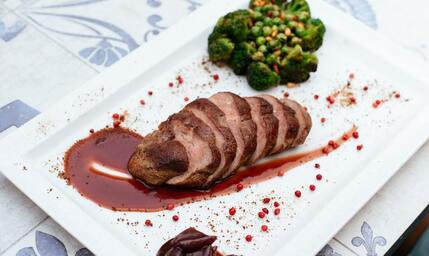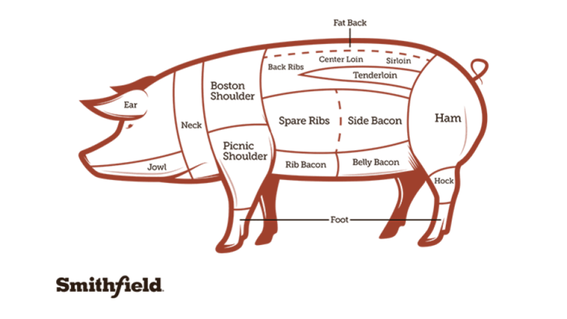It’s been used so much that you may not have even known a new slogan was introduced over 10 years ago - Pork: Be Inspired
Now, if you already knew that, please get out more (kidding). But if you’re like me and just are discovering this new slogan as of 4 minutes ago via a Google search, well, it’s good to feel like I’m not alone. Anyways…looking at that old slogan, what first came to mind was - why is pork being relegated to the “other” white meat? In the shadow of chicken and positioned as a “look at me, I’m also healthy” alternative?
I think it’s because pork was and still is a bit of an underdog - seen as less “healthy” than chicken and less glamorous than beef, pork is always out of the spotlight and often also forgotten apart from when bacon makes its appearance at the breakfast table. Well, I for one think pork should step out of the shadows. It’s time for the humble hog to shine as the star of your next meal and be the showstopper it deserves to be.
Let's dive in.
When you think of a show stopping dinner centerpiece, you may picture something like a whole roast chicken (ooooo) or a nice steak or beef roast (ahhhh), but why not try out pork tenderloin? Pork tenderloin, the tender, lean, and delicious crown jewel of the pig is easy to cook, looks stunning on the plate, is delicious, and also an amazing value compared to any steak cut of beef.
So what is pork tenderloin exactly? Well, much like beef tenderloin, it’s a relatively narrow muscle along the back of the pig. Compared to it’s beef cousin, it’s a much smaller piece of meat, often about 1lb per tenderloin. Because of where it is on the animal, it’s not a muscle that is used often or heavily, so it stays and tender and delicate - oftentimes even more so than beef.
When it comes to accessibility, pork tenderloin also is hard to beat. Looking at my local grocery store prices, pork tenderloin can be had for as little as $5.99/lb on sale, and only $8.99/lb at regular non-sale prices. That is less than half of what ribeyes currently are going for, and nearly a third of the price of beef tenderloin. And what are you getting for that price? In terms of tenderness, a well cooked pork tenderloin will knock out any ribeye, NY strip, or other sub-$40/lb cut of beef all. day. long.
So - succulent (check), tender (check), delicious (check), and affordable (triple check)? You see why we should stop sleeping on this cut of meat?
What about Pork Loin Roast?
You may also come across something called a pork loin roast at your grocery store. What’s the difference between this and a pork tenderloin?
Pork loin is a much larger, thicker cut of meat vs the relatively dainty tenderloin. If you’ve ever had a pork chop in the past - with or without the bone - you’ve probably had pork loin before. The main “meat” of a pork chop is pork loin; the loin itself is just sliced already into “steaks”. Pork loin is less tender overall than a tenderloin as the name implies, and both are very lean. I would also argue pork loin also has a little richer, “meatier” flavor vs tenderloin. If you want to dive in deeper, Allrecipes did a nice write-up here.
For the purposes of the upcoming recipe, I’ve made it with two smaller pork tenderloins as well as one larger pork loin. The flavor comes out amazing using either, but I do recommend a few small tweaks to the recipe if you're planning to use pork loin instead of tenderloin:
- Start with a nice sear with either cut of meat - this is critical to build flavor
- Monitor doneness based on temperature, not time. A single pork loin will take a good amount longer to cook than a tenderloin will (Closer to 30-40 minutes in the oven vs 12-15). Use a probe thermometer to monitor your pork, and target the same internal temperatures listed below.
- Reduce your oven slightly during roasting - we don’t want to burn the meat, and since you will be searing first, we have taken care of browning. If doing a single pork loin roast, set your oven to 375 degrees vs the 400 for tenderloin.
Things to Consider when Cooking Pork Tenderloin
- Pork tenderloin is very lean - so it’s critical to not overcook it. I recommend using a probe thermometer to help check and track the internal temperature of your pork.
- For a perfect medium doneness - target an internal temp of 135 degrees before giving the meat a 10-minute rest under foil. This will help ensure a truly juicy tenderloin that is fully cooked through.
- For medium-well, hit 140 degrees before a similar resting period.
- Why Rest? Resting is the process of giving meat time off the heat to help let it “relax” and the juices to redistribute before slicing. If you don’t rest your roast, you risk having most of your juices spilling out on the cutting board and dry meat.
- For a perfect medium doneness - target an internal temp of 135 degrees before giving the meat a 10-minute rest under foil. This will help ensure a truly juicy tenderloin that is fully cooked through.
- Get a good sear on your meat - Pork tenderloin, much like chicken breast, is relatively mild in flavor on its own. Getting a good sear and browning on the outside will add loads of richness and depth to your final dish. We accomplish this in the upcoming recipe by searing the pork in a hot pan before finishing it in the oven.
- Bright flavors and fruit are a pig’s best friend - Pork plays amazingly well with bold sauces and fruit. Ever had a pork chop and it was served with applesauce? Or the takeout classic sweet and sour pork? Each is amazing in their own way, but share a thread of sweet and tart flavors that makes the meat shine. Apple is the most common flavor associated with pork, at least in the West, and I’m going to be using apple cider and a touch of mustard as the base of my sauce.
Alright - you've made it this far. Congrats! Give this recipe and technique a try the next time you’re pondering what’s for dinner and let me know how it goes in the comments.
Recipe: Roast pork tenderloin with cider mustard sauce
Serves: 4-5
For the Pork:
- 2 Pork Tenderloins, trimmed - about 2.5 lbs total
- Alternatively, you can use a boneless pork loin roast (about 2.5-3 lbs)
- 1-2 tablespoon Vegetable oil to sear
- Salt and Pepper
For the cider-mustard sauce:
- 2 cups apple cider
- 1/2 cup water + 1 generous tsp Better than Boullion Chicken base (Or use 1/2 cup chicken stock)
- 1-2 tsp apple cider vinegar
- 1 clove garlic, minced
- 1 large shallot, minced
- Can substitute 1 small or ½ medium onion, minced, if needed
- 1 tsp fresh thyme leaves, chopped
- 1 tsp dijon mustard
- 1 tablespoon butter
- Salt and pepper to taste
Directions:
- Preheat your oven to 400 degrees fahrenheit
- Dry your pork tenderloins thoroughly with paper towels and season generously with salt and pepper on all sides
- Heat a large stainless steel or cast iron pan over medium-high heat, add 1-2 tablespoons oil to coat the bottom of the pan, and sear tenderloins until browned on all sides (About 3 minutes per 1/3 side)
- Transfer your seared pork onto a wire baking rack placed on a baking sheet. Roast in a 400 degree oven for 12-15 minutes until a probe thermometer reads 135-140 degrees in the thickest part of the tenderloin.
- Remove the two roasts from the oven and onto a cutting board. Cover with foil and rest at least 10 minutes before slicing.
- While the pork is roasting - In same pan used to sear the pork, cook the minced shallot over medium heat in the remaining oil (adding 1 tsp fresh oil if needed) until softened and lightly browned, about 5 minutes. Add the garlic and thyme and cook for 30 seconds.
- Add the apple cider, vinegar, water, and chicken base to the pan and scrape the browned bits from the pork off the bottom of the pan. Bring the liquid to a boil over high heat and cook, boiling, until the liquid is reduced to 1/3 of its original volume. About 10-15 minutes.
- Reduce heat to medium low on the sauce, add butter and mustard, and whisk together until incorporated. Taste and add salt and pepper to preference. Keep warm until pork is ready to serve.
- Once rested, slice pork tenderloin thickly and serve with sauce.
Cheers,
Phil




